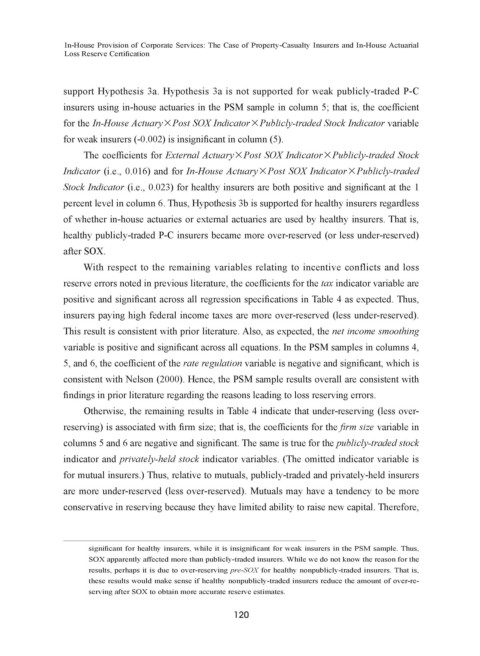Page 128 - 34-1
P. 128
In-House Provision of Corporate Services: The Case of Property-Casualty Insurers and In-House Actuarial
Loss Reserve Certification
support Hypothesis 3a. Hypothesis 3a is not supported for weak publicly-traded P-C
insurers using in-house actuaries in the PSM sample in column 5; that is, the coefficient
for the In-House Actuary×Post SOX Indicator×Publicly-traded Stock Indicator variable
for weak insurers (-0.002) is insignificant in column (5).
The coefficients for External Actuary×Post SOX Indicator×Publicly-traded Stock
Indicator (i.e., 0.016) and for In-House Actuary×Post SOX Indicator×Publicly-traded
Stock Indicator (i.e., 0.023) for healthy insurers are both positive and significant at the 1
percent level in column 6. Thus, Hypothesis 3b is supported for healthy insurers regardless
of whether in-house actuaries or external actuaries are used by healthy insurers. That is,
healthy publicly-traded P-C insurers became more over-reserved (or less under-reserved)
after SOX.
With respect to the remaining variables relating to incentive conflicts and loss
reserve errors noted in previous literature, the coefficients for the tax indicator variable are
positive and significant across all regression specifications in Table 4 as expected. Thus,
insurers paying high federal income taxes are more over-reserved (less under-reserved).
This result is consistent with prior literature. Also, as expected, the net income smoothing
variable is positive and significant across all equations. In the PSM samples in columns 4,
5, and 6, the coefficient of the rate regulation variable is negative and significant, which is
consistent with Nelson (2000). Hence, the PSM sample results overall are consistent with
findings in prior literature regarding the reasons leading to loss reserving errors.
Otherwise, the remaining results in Table 4 indicate that under-reserving (less over-
reserving) is associated with firm size; that is, the coefficients for the firm size variable in
columns 5 and 6 are negative and significant. The same is true for the publicly-traded stock
indicator and privately-held stock indicator variables. (The omitted indicator variable is
for mutual insurers.) Thus, relative to mutuals, publicly-traded and privately-held insurers
are more under-reserved (less over-reserved). Mutuals may have a tendency to be more
conservative in reserving because they have limited ability to raise new capital. Therefore,
significant for healthy insurers, while it is insignificant for weak insurers in the PSM sample. Thus,
SOX apparently affected more than publicly-traded insurers. While we do not know the reason for the
results, perhaps it is due to over-reserving pre-SOX for healthy nonpublicly-traded insurers. That is,
these results would make sense if healthy nonpublicly-traded insurers reduce the amount of over-re-
serving after SOX to obtain more accurate reserve estimates.
120

